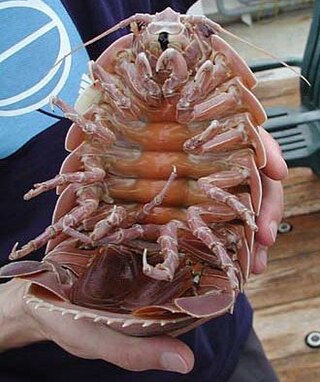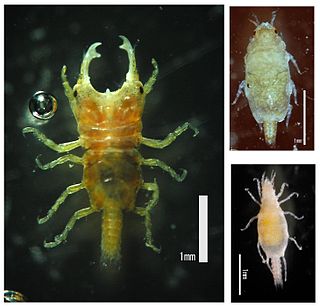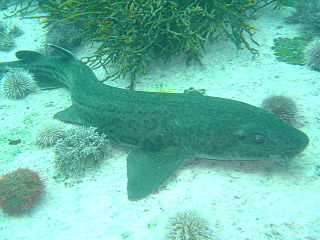
A larva is a distinct juvenile form many animals undergo before metamorphosis into their next life stage. Animals with indirect development such as insects, amphibians, or cnidarians typically have a larval phase of their life cycle.

Tantulocarida is a highly specialised group of parasitic crustaceans that consists of about 33 species, treated as a class in superclass Multicrustacea. They are typically ectoparasites that infest copepods, isopods, tanaids, amphipods and ostracods.

Isopoda is an order of crustacean, which includes woodlice and their relatives. Members of this group are called Isopods and include both terrestrial and aquatic species. All have rigid, segmented exoskeletons, two pairs of antennae, seven pairs of jointed limbs on the thorax, and five pairs of branching appendages on the abdomen that are used in respiration. Females brood their young in a pouch under their thorax.

Bathynomus giganteus is a species of aquatic crustacean, of the order Isopoda. It is a member of the giant isopods (Bathynomus), and as such it is related—albeit distantly—to shrimps and crabs. It was the first Bathynomus species ever documented and was described in 1879 by French zoologist Alphonse Milne Edwards after the isopod was found in fishermen's nets off the coast of the Dry Tortugas in the Gulf of Mexico.

The family Argulidae, whose members are commonly known as carp lice or fish lice, are parasitic crustaceans in the class Ichthyostraca. It is the only family in the monotypic subclass Branchiura and the order Arguloida, although a second family, Dipteropeltidae, has been proposed. Although they are thought to be primitive forms, they have no fossil record.

The superorder Peracarida is a large group of malacostracan crustaceans, having members in marine, freshwater, and terrestrial habitats. They are chiefly defined by the presence of a brood pouch, or marsupium, formed from thin flattened plates (oostegites) borne on the basalmost segments of the legs. Peracarida is one of the largest crustacean taxa and includes about 12,000 species. Most members are less than 2 cm (0.8 in) in length, but the largest is probably the giant isopod which can reach 76 cm (30 in). The earliest known perecaridian was Oxyuropoda ligioides, a fossil of which has been found dating to the Late Devonian of Ireland.

The Gnathiidae are a family of isopod crustaceans. They occur in a wide range of depths, from the littoral zone to the deep sea. The adults are associated with sponges and may not feed. The juvenile form is known as a 'praniza', and it is a temporary parasite of marine fish. These forms are not larvae; Gnathiidae instead become parasitic during the manca stage. Mancae of the Gnathiidae closely resemble the adult form, however they lack the final pair of pereiopods.

The leopard catshark is a species of catshark, and part of the family Scyliorhinidae, endemic to the coastal waters of South Africa. Abundant in inshore waters under 20 m (66 ft) deep, this bottom-dweller favors rocky reefs, kelp beds, and sandy flats. Growing to a length of 84 cm (33 in), the leopard catshark has a stout body with two dorsal fins placed well back, and a short head and tail. It is extremely variable in color and pattern, with individuals ranging from almost white to black and covered by diverse patterns of black spots, blotches, rosettes, and/or lines. The color pattern changes with age and some forms seem to be location-specific, suggesting the presence of multiple distinct, local populations. In the past, some of the more distinct color forms have been described as different species.

Iais pubescens is a species of marine isopod in the family Janiroidea. It inhabits seashores in a large number of locations in the southern hemisphere and may be found both free-living, and as commensals on larger isopods.

A woodlouse is any crustacean belonging to the suborder Oniscidea within the order Isopoda. They get their name from often being found in old wood, and from louse, a parasitic insect, although woodlice are neither parasitic nor insects.

Paracerceis sculpta is a species of marine isopod between 1.3 millimetres (0.05 in) and 10.3 mm (0.41 in) in length. The species lives mainly in the intertidal zone, and is native to the Northeast Pacific from Southern California to Mexico, but has since been introduced to many other countries. Adults are herbivorous and consume algae but juveniles are carnivorous and consume moulting females. They reproduce in sponges but do not feed near them.

Crustaceans may pass through a number of larval and immature stages between hatching from their eggs and reaching their adult form. Each of the stages is separated by a moult, in which the hard exoskeleton is shed to allow the animal to grow. The larvae of crustaceans often bear little resemblance to the adult, and there are still cases where it is not known what larvae will grow into what adults. This is especially true of crustaceans which live as benthic adults, more-so than where the larvae are planktonic, and thereby easily caught.

Gnathia is a genus of isopod crustaceans, containing the following species:

Gnathia marleyi is a species of crustacean in the family Gnathiidae. It is named after reggae musician Bob Marley. It is a parasite that infests and feeds on the blood of such fish as the French grunt. This tiny species is only found in the Caribbean Sea. It only eats while in the juvenile stage. It can be found hiding among sea sponges, algae, and pieces of dead coral.

Gastrosaccus spinifer is a shrimp-like crustacean in the order Mysida, the opossum shrimps, native to the eastern Atlantic Ocean and the coasts of Northern and Western Europe.
Prodajus ostendensis is a species of marine isopod in the family Dajidae and is found in the North Sea. It is an ectoparasite of the opossum shrimp Gastrosaccus spinifer. It is normally found living in the host's marsupium and devouring its eggs.

Helleria brevicornis, the sole species of the monotypic genus Helleria, is a terrestrial woodlouse endemic to the islands and coastal regions of the northern Tyrrhenian sea. H. brevicornis is of interest due to its endemism, unique ecology and basal position in the suborder Oniscidea.

Arrenurus is a genus of water mites within the family Arrenuridae, and was first described by Antoine Louis Dugès in 1834. It has a cosmopolitan distribution in lentic waters, even on remote Pacific islands, and is found on every continent, with the possible exception of Antarctica. Some 950 species are currently recognised, making Arrenurus the largest of genera.

Ceratothoa oestroides is a crustacean isopod, obligate ectoparasite of marine fish that dwells in the buccal cavity. It is the causative agent of various pathologies including tissue damage at the parasitisation site (tongue), growth defects, decrease in mean host weight and size and increases mortalities in farmed and wild fish populations. It has been recorded in six different fish families: Sparidae, Carangidae, Clupeidae, Maenidae, Scorpenidae, and Mugilidae.

Ceratothoais a genus of isopod ectoparasites of teleost fish, first described by James Dwight Dana in 1852. Infection by Ceratothoa can cause anaemia, lesions, growth retardation, emaciation, and mortality in their fish hosts.

















